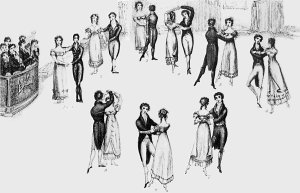A few weeks ago, I had the chance to take part in a display of dancing for a heritage open day. We were doing regency dances, but the display began with a couple minuet. One of the other dancers asked if it was a regency minuet and I had to admit that it was not, but the question got me thinking about what a regency minuet might have been like.
Were minuets still being danced in the regency period? George, Prince of Wales was sworn in as Prince Regent for his father George III on 6 February 1811, and he succeeded him as king on 29 January 1820. A quick survey of newspaper references to the minuet during the first and last years of the regency reveals that it was still being taught, and performed at balls, throughout that period. I didn’t have time to do a thorough search, but I quickly came across advertisements by dancing masters who continued to include the minuet among the dances they offered. The Morning Post for 23 January 1810 has one by Thomas Wilson, who lists minuets alongside cotillions, hornpipes and country dances. The Morning Herald for 6 April 1818 has another by Mr Cunningham, who was offering ‘Quadrilles, Waltzes, Spanish Dances, Minuets, &c. Taught in the most fashionable style’. The following year, in the Morning Post for 12 November 1819, Mr Levien in his turn offered quadrilles, waltzes, minuets and country dances, ‘or any other department of Fashionable Dancing’. The minuet seems to have been far from dead, at least so far as dancing masters were concerned.
The reports and advertisements for balls show that the minuet was still the opening dance, performed by a suitably high-ranking couple. The ball on Lord Mayor’s Day, reported in the Morning Chronicle for 11 November 1811, was ‘opened in a Minuet by the Duke del Infantado, the Spanish Ambassador, and Lady Georgiana Cecil’. However, one indication of the changes that were happening appears in the report of the Lord Mayor’s Easter Monday ball in the Morning Chronicle for 15 April 1819. The Earl of Morton and Miss Atkins danced the Menuet de la Cour, and the writer declared that ‘Nothing could be more elegant and graceful’. The report did not reveal whether the ball opened with this dance but it did explain that ‘It was originally intended that the minuet should conclude with the usual Gavot as danced at the Opera House, but that part of the performance was omitted, as being inconsistent with the dignity of his Lordship’s character as Lord High Commissioner to the Grand Assembly of the Church of Scotland’. The ‘Gavot’ was, of course, the Gavotte de Vestris. Other changes involving the minuet are also evident from the newspapers, although I will not pursue these here.
The Menuet de la Cour dated back to the late 1770s and seems to have been introduced to London in 1781, when Gaëtan Vestris and his wife Anne Heinel danced it in the ballet-pantomime Ninette à la Cour. This duet (with and without the Gavotte de Vestris) would become a staple of benefit performances in London’s theatres. The original choreography would undergo many transformations in the course of an exceptionally long afterlife. The version published in notation by Malpied around 1780 shows clearly that, although the Menuet de la Cour included some of the minuet’s long-established figures, its steps went well beyond those prescribed by Pierre Rameau and Kellom Tomlinson in the earlier 1700s. This may have made it a suitable basis for the development of this exacting exhibition dance in the decades around 1800. Here is the opening figure of the dance, following the reverences (also notated by Malpied), in which there is not a single conventional pas de menuet.
One question hovering in the background of the regency minuet is to do with dress. The minuet had begun its long career in the late 17th century and had seen many changes of silhouette during the course of the 18th century, particularly for women. This illustration, which dates to the mid-1700s, shows one of them.
How was this most formal and, apparently, inhibited of dances adjusted to the free-flowing female dress of the regency and for dancers who were at the same time experiencing the very different movement style of the early waltz? This print, published in 1813, shows Princess Charlotte (the Prince Regent’s daughter) dancing a minuet with William Cavendish, 6th Duke of Devonshire. I can’t help thinking that the style and technique of the minuet, as well as its figures and its steps, were forced to change alongside the revolutions in dress and dancing.
There was one obvious attempt to bring the old duet up to date. The Sunday Monitor for 20 April 1817 has an advertisement by Thomas Wilson for a ‘Waltz and Quadrille Ball’ which ‘will be opened … by Mr. Wilson and a Young Lady, one of his Pupils, with the Waltz Minuet, composed by Mr. Wilson’. I know that the basic waltz step suggested by Wilson in his 1816 treatise A Description of the Correct Method of Waltzing bears an interesting relationship to the minuet step. I am hoping that there is somebody out there who knows (or can find out) how the ‘Waltz Minuet’ was performed. I would be happy to attend a workshop!







